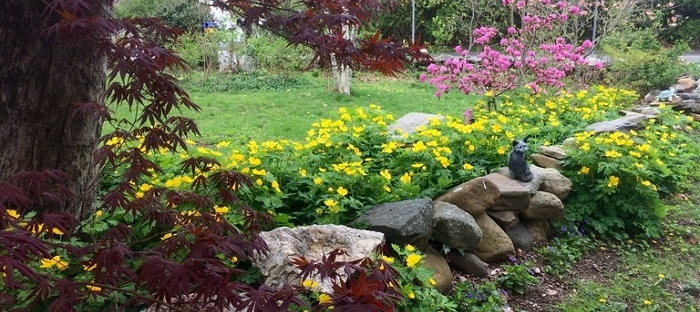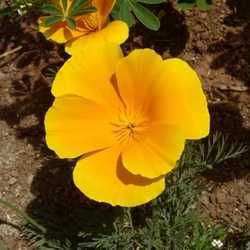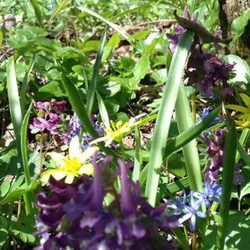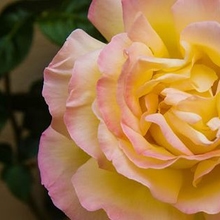When I first saw them, at Longwood Gardens in Pennsylvania, I didn't know what they were. It was enough that they were shade tolerant, bright yellow and attractive spring green leaves. The flowers were poppy-like, in an un-poppyish but beautiful shade of yellow and about two inches across. This chance encounter started me on a years long project delving into the specifics of two different "Celandine poppies."
Fast forward a year- someone offered me "wood poppies" from her garden. These were a double flowered type, with a cultivar name 'Flore Pleno' (which generally means 'double flowered'). They grew readily under my maples. But they weren't quite the ones I remembered in Longwood. The 'Flore Pleno' were charming in a different, more delicate way. The flowers had tiny petals in layers, creating yellow pompoms about a half-inch across. They were sweet, but not what I was looking for.
What I had originally seen was Stylophorum diphyllum, a native North American wood poppy. Seen above in the lead image. And somehow, I acquired those plants as well. Another generous friend, or a sale by a native plant society? I just don't remember which, but somehow they ended up in my garden. I thought I'd plant the new native poppies alongside the European ones, and have a nice big bed of yellow spring poppies in the shade. I should have thought this through.
Fast forward two years. Why did I ever place two nearly identical flowers right next to each other? I'm too compulsive to have them mix and mingle. Mingle they did, too, the European one seeding vigorously, the American one not so much. I found the plants maddeningly similar at many growth stages. But I was determined to sort them out.
What's more, as I read about wood poppies, I decided to eliminate the European one from my yard altogether. Chelidonium majus, native of Europe, (shown below) has become widespread across most of eastern North America, crowding out some native wildflowers. While it isn't actually considered invasive, why give it a chance to reach that designation. I decided that I'd eradicate it from my yard, and keep all the Stylophorum seedlings and overwintering plants. It also has a sketchy history in herbal medicine and tests show that it probably does more harm than good, so it is best to avoid it in that respect as well.
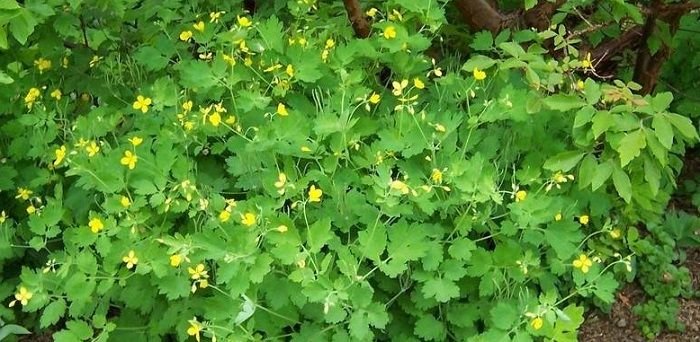
But in order to do that effectively, I'd have to be able to recognize both plants at all times of the year. I've made careful observations and have learned how to tell the difference between the two nearly identical plants. Well, at least in my yard, where I still have some of each for "compare and contrast" exercises.
Chelidonium majus: Keeping at least a few leaves all through winter in my zone, the young plants in spring have a more open base and lots of white fuzz in the center of the plant on the petioles of the young leaves. Later, the leaves are more elongated than those of Stylophorum. Plants in bloom are easy to tell, Chelidonium flowers are small, less than an inch across, and more plentiful. It also reblooms a little in summer. Seed pods are skinny, slightly bumpy, and smooth, pointing up. Chelidonium begins blooming a week or two later later than Stylophorum diphyllum, and can rebloom lightly through summer. Cool fall weather can find this plant becoming lush with foliage; it tolerates and even enjoys cool weather.
Stylophorum diphyllum: All foliage disappears from these plants over winter in my yard. The mature plants emerge in early spring. The rosette is dense with new leaves crowding the base. New leaves are tinged with purple underneath, petioles are very short, purple tinged, and only lightly fuzzy. As leaves develop, they are more rounded than the Chelidonium. Flowers are larger, over an inch across. Seed pods are fat, fuzzy, and hang down. Blooming begins during daffodil season mid spring; my Stylophorum begins to bloom about two thirds of the way through the daffodil season. Later in summer, the Stylophorum leaves are more rounded in outline. In fall, these leaves begin to turn yellow and bronze, and are completely shed in winter.
I cannot say which plant is "better" in the garden. But I can say that living intimately with these two plants has honed my plant observation and identification skills. It is important to be aware of how each plant looks and behaves in your garden. And I've really learned my lesson about planning before I plant.
Images courtesy of PlantFiles
